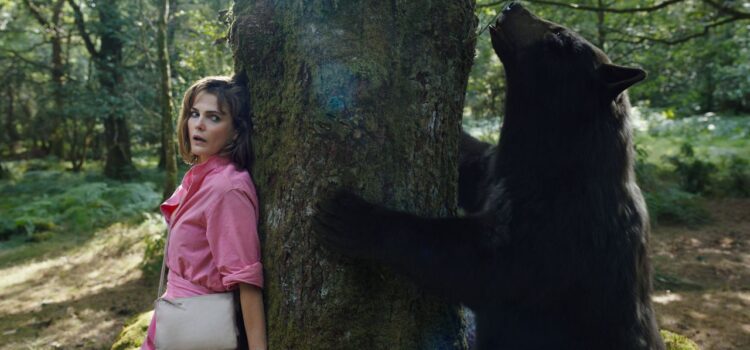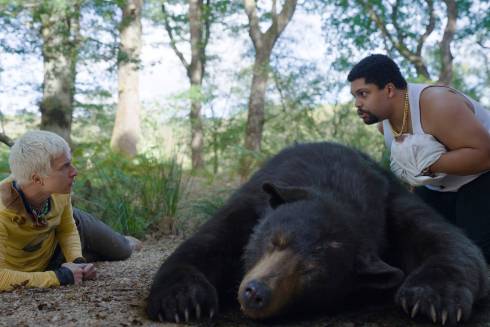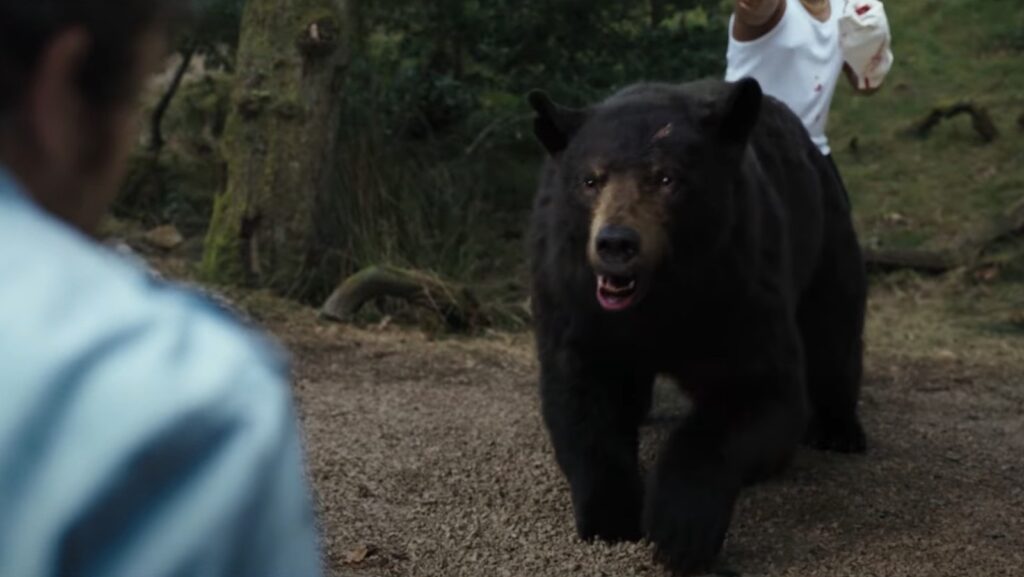By Alex McPherson
Featuring outrageous kills and directorial craft, Osgood Perkins’ “The Monkey” is a nihilistic experience that undermines its potential through a reliance on hit-or-miss dark comedy — substituting emotional connection for blunt-force laughter and smug pessimism about the state of humanity.
Based on the short story by Stephen King, Perkins’ film begins with pilot Petey Shelborn (Adam Scott) attempting to return the titular drum-playing toy monkey to an antiques shop, but not having much success (the shop’s owner meets a grisly end, to put it mildly). Petey takes a flamethrower to the little rascal, but the monkey doesn’t give up so easily.
Years later, in 1999, Petey’s young children, identical twins Hal and Bill (both played by Christian Convery) are living with their mother (Tatiana Maslany), with Petey no longer in the picture. Hal is the more sensitive, soft-spoken one, whereas Bill is a popular, immature bully, often humiliating his brother at school.
While looking through their father’s belongings one random day, the boys find the monkey, and things start to get tragic. Hal and Bill are unnerved but intrigued by this creepy contraption. They wind the key on the monkey’s back, watch its mouth open into a toothy grin, and see its drumstick spin theatrically.
The boys have absolutely no idea that, when the monkey starts to play the drum that evening, accompanied by circus music, their babysitter will get decapitated at a Teppanyaki restaurant.

Everyone is shocked by the suddenness and brutality of the death (including the priest at her funeral service, who stumbles through his sermon in darkly funny fashion), but Hal — who feels like the monkey is watching and stalking him at any given moment — suspects he knows who, or what, is behind it.
And, after being humiliated yet again at school, Hal sees a chance to get the revenge he’s craved his whole life against Bill. But the monkey doesn’t take requests, resulting in further tragedies that tear the family apart, and in the monkey being thrown into a nearby well, hopefully never to be heard again.
Flash forward 20 years, and the all-grown-up, at least physically, Hal (now played by Theo James) is a deadbeat dad estranged from his son, Petey (Colin O’Brien), drifting through life without much enthusiasm or purpose.
When their kooky Aunt Ida (Sarah Levy) meets a demise of R-rated “Looney-Tunes” proportions, Bill (also played by James) contacts Hal out of the blue to reveal that, yes, the monkey is back for more bloody shenanigans, and there’s no running away this time.

Perkins, who directed last year’s “Longlegs,” has a knack for creating unsettling worlds where violence could occur at any point. “The Monkey,” though, represents a stylistic departure in terms of its cartoonish, deadpan instincts that encourage viewers to laugh at the carnage — it’s best viewed in a packed theater with viewers willing to go along with its warped sense of humor.
Without real emotional connection, however, “The Monkey” eventually wears out its welcome by not fully exploring its themes and presenting characters that are difficult to latch onto amid Perkins’ devilishly sardonic tendencies.
Indeed, there’s definitely merit to the off-kilter, desensitized world that Perkins depicts here, and the skillful ways he crafts suspense through patient camera movements and editing that jolts and amuses in equal measure.
The film plays with expectations and takes obvious glee in putting the story’s hapless characters in harrowing situations where, should that monkey kick into gear, their fates are essentially sealed.
The kills are memorably gory throughout, usually ending in exploding limbs and showers of blood. The bulk of the film’s crowd-pleasing entertainment value comes from watching what elaborate scenario Perkins concocts for us next; he encourages us to laugh at the craziness, which ensures “The Monkey” is never boring.

Perkins doesn’t spend time delving into the monkey’s origins or how it came to focus on Hal and his family. It’s a smiling, omnipresent manifestation of death, fueled by hatred of the Other and remaining ambiguous in its targets — except that it never chooses the one who winds the key. This idea is compelling, as is the film’s timely perspective on continuing to live amid the anarchy in whatever way we can and break cycles of trauma.
The film’s main issues stem from a lack of strong characterization, especially as the screenplay resorts to third-act exposition dumps (also a flaw in “Longlegs”), and tends to undercut its fleeting moments of sincerity with blood-spattered punchlines that leave little room for reflection. Perkins ultimately takes the easy way out rather than thoughtfully engaging with the story’s themes.
The ensemble — Maslany and James especially — do what they can to add extra layers to their characters through their easy charisma and ability to convey unspoken pain, but there’s no escaping the film’s exhaustingly snarky sensibilities.
It’s apparent that “The Monkey” is deeply personal to Perkins, who experienced unimaginable family tragedy himself. But regardless of how he and this film use humor as a deflection from trauma, it creates a distancing effect that numbs and dilutes the film’s messages and, finally, lessens the impact of its twistedly hopeful ending.
At the end of the day, “The Monkey” is a strange beast — defiantly marching to the beat of its own sinister drum but seemingly forgetting to give its characters the same attention.

“The Monkey” is a 2025 horror-comedy thriller directed and written by Osgood Perkins. It stars Theo James, Christian Convery, Tatiana Maslany, Adam Scott, Sarah Levy and Colin O’Brien. Rated R for strong bloody violent content, gore, language throughout and some sexual references and runs for 1 hour, 38 minutes. It opened in theaters March 7. Alex’s Grade: B-,
Alex McPherson is an unabashed pop culture nerd and a member of the St. Louis Film Critics Association.




